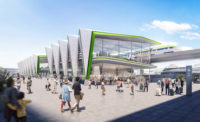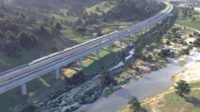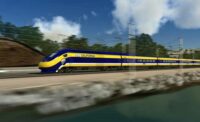For Southern Californians, Las Vegas is tantalizingly close geographically, but painfully distant temporally. The drive across the desert typically takes more than four hours, even without counting traffic congestion on the trip's onset.
The prospect of paring down the time and limiting the driving the trip requires took a step forward this week with the groundbreaking of Brightline West's high-speed rail line on April 22. When complete, the full trip between stations in Rancho Cucamonga and Las Vegas will take about two hours, or roughly half the current driving time.
“People have been dreaming of high-speed rail in America for decades – and now, with billions of dollars of support made possible by President Biden’s historic infrastructure law, it’s finally happening,” said U.S. Dept. of Transportation Secretary Pete Buttigieg at the event.
The $12-billion effort to construct a 218-mile-long high-speed rail line between Las Vegas and Southern California began with a blast of confetti and the ring of hammers on rail at the site of the planned station in Las Vegas. The rail line will run down the middle of the I-15 Freeway, using zero-emission electric trains capable of speeds of 200 miles per hour.
The route for the train has full environmental clearance and will run within the median of the interstate. Trains will stop in Las Vegas, Nevada, as well as Victor Valley, Hesperia and Rancho Cucamonga, California.
“This is a historic project and a proud moment where we break ground on America’s first high-speed rail system and lay the foundation for a new industry,” said Wes Edens, Brightline founder, at the event.
Brightline, the only private provider of eco-friendly, intercity passenger rail service in America, says the privately-led infrastructure project will be constructed and operated by union labor. Expected to complete in time for the 2028 Olympics, the rail line will also include 322 miles of overhead lines to power the trains, and 3.4 million sq-ft of retaining walls.
Although a contractor for the project has not yet been selected, the civil and rail infrastructure portion of the project is being led by HNTB in California and Jacobs in Nevada.
Finding Financial Backing
Last December, the Nevada Dept. of Transportation (NDOT) was awarded $3 billion in funding from the Federal-State Partnership for Intercity Passenger Rail Grant Program for the Brightline West project. The $3-billion grant is the largest in NDOT’s history. As the grant administrator, the agency will continue to play an important oversight role as Brightline West constructs the rail system. Additionally, NDOT will be responsible for the design, construction, and oversight of any infrastructure that requires modification as a result of Brightline West’s work.
The rest of the project costs will be privately funded although the federal government has taken steps to assist in making financing more attractive for investors. To date, the project has received a total allocation of $3.5 billion in private activity bonds from USDOT. The bonds give privately financed transportation projects access to tax-exempt bonds. That reduces the borrower's interest rate for the bonds and, DOT says, increases the private sector's presence in financing infrastructure projects.

Map courtesy Nevada Dept. of Transportation
The Las Vegas station will sit on 110 acres and include easy connections and access to the Las Vegas Strip, the NFL’s Raiders’ Allegiant Stadium and the Las Vegas Convention Center. Brightline West’s California stations will include Victor Valley and Rancho Cucamonga, with direct connectivity via California Metrolink to key points in Los Angeles, such as Union Station.
A 200,000-sq-ft Vehicle Maintenance Facility (VMF) is also part of the project and will be located in Sloan, Nevada. It will be the base for daily maintenance and staging of trains.
The project’s environmental features are designed in line with Nevada and California’s climate strategies by promoting a no-emission mobility option that lowers greenhouse gasses by more than 400,000 tons of CO2 each year. By taking people out of cars and planes, the project will reduce vehicle miles traveled by more than 700 million each year and 16,000 short haul flights annually, says the company.
To further reduce the projects environmental impact, Brightline West has penned an agreement with the California Department of Fish and Wildlife (CDFW) to include wildlife crossings along the route. These will cross over the existing northbound and southbound highway lanes and the future high-speed rail system to be built within the median.






Post a comment to this article
Report Abusive Comment